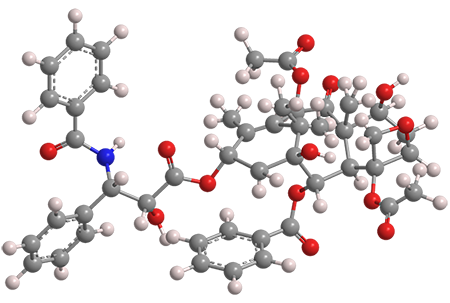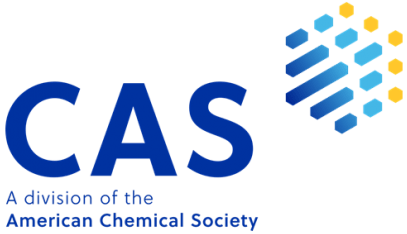What molecule am I?


Paclitaxel, commonly known by its trade name Taxol, is a chemotherapy drug that has been used to treat many types of cancer. Despite its several adverse side effects, it is on the World Health Organization's List of Essential Medicines.
In 1971, as the sixth part of a series of articles on plant antitumor agents, Mansukh C. Wani and colleagues at the Research Triangle Institute (NC) and Duke University (Durham, NC) reported the isolation of a complex molecule from the bark of the Pacific yew tree (Taxus brevifolia) that they named “taxol”. In the article’s introduction, the authors state, “Taxol has potent antileukemic and tumor inhibitory properties and is the first compound possessing the taxane ring [that] has been demonstrated to have such activity.” The taxane “ring” is actually a tricyclic structure that forms the core of the molecule (see images).
Wani et al. provided very little information about “taxol’s” anticancer activity; the article focused on the chemistry and spectra of the compound and some of its derivatives. During the next two decades, Wani, his colleague Monroe E. Wall, and several other researchers, under the auspices of the National Cancer Institute (NCI), investigated the potential drug’s activity against various cancers. They began clinical trials in 1984. During the 1970s and ’80s, almost 10 t of Pacific yew bark were harvested and extracted for experimental work and the trials.
Finally, in 1989, NCI offered to turn the project over to a commercial pharmaceutical company. The offer generated surprisingly little interest; but by the end of the year, the technology was transferred to Bristol-Meyers Squibb (BMS)—the same year that the BMS merger was concluded. BMS obtained the generic name paclitaxel for the drug and registered the brand name Taxol with the US Office of Patents and Trademarks. The NCI–BMS deal and the trademarked name soon became the subject of much controversy.
BMS received its first drug approval for paclitaxel from the US Food and Drug Administration in 1992. As of 2018, FDA approvals include treatment of breast, pancreatic, ovarian, and non–small-cell lung cancers; and Kaposi's sarcoma. Paclitaxel has been extremely thoroughly researched: As of this writing, SciFinder lists 73,164 references, including mentions in 68 United States and international patents.
Paclitaxel hazard information*
| Hazard class** | Hazard statement | |
|---|---|---|
| Acute toxicity, oral, category 4 | H302—Harmful if swallowed | |
| Acute toxicity, dermal, category 4 | H312—Harmful in contact with skin | |
| Skin corrosion/irritation, category 2 | H315—Causes skin irritation | |
| Skin sensitization, category 1 | H317—May cause an allergic skin reaction | |
| Serious eye damage/eye irritation, category 1 | H318—Causes serious eye damage | |
| Acute toxicity, inhalation, category 4 | H332—Harmful if inhaled | |
| Respiratory sensitization, category 1 | H334—May cause allergy or asthma symptoms or breathing | |
| Specific target organ toxicity, single exposure, respiratory tract irritation, category 3 | H335—May cause respiratory irritation | |
| Germ cell mutagenicity, category 2 | H341—Suspected of causing genetic defects | |
| Reproductive toxicity, category 1B | H360—May damage fertility or the unborn child | |
| Hazardous to the aquatic environment, long-term hazard, category 4 | H413—May cause long-lasting harmful effects to aquatic life | |
*Globally Harmonized System of Classification and Labeling of Chemicals.
Explanation of pictograms.
This molecule was suggested by a reader. We present almost all of the molecules suggested by our readers. If you have a molecule you would like us to consider, please send us a message. And thank you for your interest in Molecule of the Week! —Ed.
Paclitaxel fast facts
| CAS Reg. No. | 33069-62-4 |
| SciFinder nomenclature | See SciFinder listing |
| Empirical formula | C47H51NO14 |
| Molar mass | 853.91 g/mol |
| Appearance | White crystalline powder |
| Melting point | 213–216 ºC |
| Water solubility | ≈10–20 mg/L (est.) |
MOTW update
N-Nitrosodimethylamine (NDMA) was the Molecule of the Week for January 14, 2019. It is used to make rocket fuel; but, because it is extremely toxic, it is notorious for its use in some fatal poisonings. NDMA and other nitrosamines have been found as impurities in several prescription drugs. Earlier this month, the US Food and Drug Administration issued guidelines on acceptable limits of six nitrosamine impurities. The limit set for NDMA is 96 ng/day.

Learn more about this molecule from CAS, the most authoritative and comprehensive source for chemical information.
Molecule of the Week needs your suggestions!
If your favorite molecule is not in our archive, please send us a message. The molecule can be notable for its current or historical importance or for any quirky reason. Thank you!
Stay Ahead of the Chemistry Curve
Learn how ACS can help you stay ahead in the world of chemistry.

